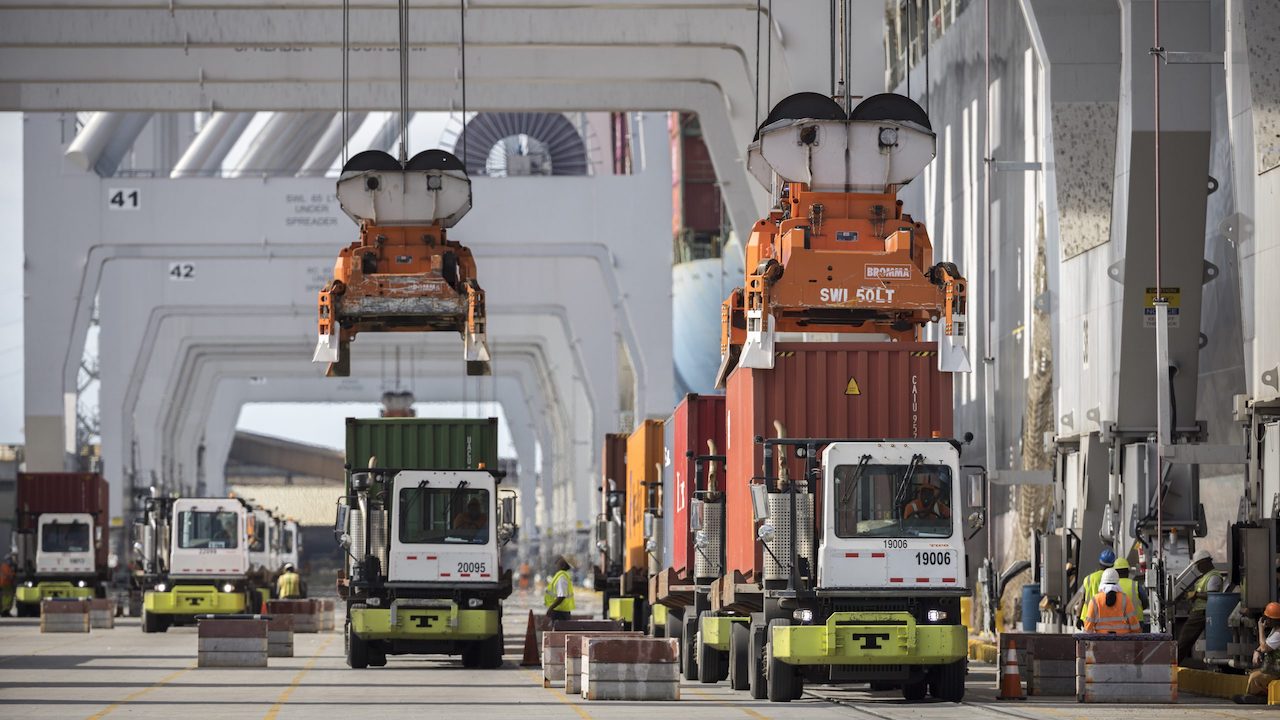
Intermodal Briefs: Port of Savannah, Port of Los Angeles
Written by Carolina Worrell, Senior Editor
Export containers are loaded onto a Yang Ming vessel at the Port of Savannah’s Garden City Terminal. GPA says it is moving cargo at a rate of more than 6 million TEUs per year. (GPA/Stephen Morton)
Port of Savannah handles more than 575,000 twenty-foot equivalent container units (TEUs) in August. Also, Port of Los Angeles cargo volume eases in August.
Port of Savannah
The Georgia Ports Authority (GPA) announced on Sept. 13 that the Port of Savannah handled 575,513 TEUs in August, an increase of 18.5% or 89,918 TEUs over the same month last year.
Counting the July volume of 530,800 TEUs, the Port of Savannah’s August performance made for “the fastest period in which the port has cleared the one million-TEU mark in a fiscal year,” GPA said.
“The Port of Savannah’s geographic and capacity advantages remain a driving force behind current and new customers deciding to move cargo through Georgia,” said GPA Executive Director Griff Lynch. “Our central location, and service through the largest container terminal in the Western Hemisphere offers speed to market and unmatched room to grow.”
According to GPA, intermodal volumes, including operations at Garden City Terminal and the Appalachian Regional Port, totaled nearly 51,700 rail lifts in August, up by more than 4,000 lifts compared to the same month last year.
In November 2021, GPA says it commissioned the final nine of 18 working tracks on its Mason Mega Rail Terminal, increasing rail capacity by 30%. Served by Class I railroads Norfolk Southern (NS) and CSX, the 85-acre rail yard is the largest of its kind for a port terminal in North America, according to the Authority.
“The investments we have made in our operating infrastructure have been paying off in our ability to handle the sustained influx of business that began two years ago,” said GPA Chairman Joel Wooten. “Combined with a deeper harbor, our improved rail capabilities and expanded container yard space have allowed GPA to maintain fluid cargo management.”
While the Port of Savannah continues to work through a vessel backlog, Lynch noted imports on the water are trending downward compared to July, when there were 265,000 containers destined for Savannah. Today, that number is 223,460 boxes on the water. Lynch said the number of vessels at anchor will “dwindle over the next six weeks, and a more permanent solution will come online in June 2023, when improvements to Container Berth 1 at Garden City Terminal are completed.”
According to GPA, work to realign the berth is now more than 60% complete. The improvement, GPA says, will provide space for another big ship berth, allowing the Port of Savannah to simultaneously serve four 16,000-TEU vessels, as well as three additional ships.
“This is a rare project for a U.S. port,” Wooten said. “By this time next year, an additional big ship berth in Savannah will have increased our ability to move containers on and off vessels by 1.4 million TEUs per year.”
In a related project, GPA says it has ordered eight new ship-to-shore cranes, set to be commissioned in December 2023. Additionally, work has begun on the Garden City Terminal West Expansion Phase II. According to GPA, the project will add 90 acres of container storage space to be supported by 15 electric rubber-tired gantry cranes and will add 1 million TEUs of annual container handling capacity, coming online in phases in 2023 and 2024.
Port of Los Angeles
After “record-breaking” cargo volume in 2021 and the first half of 2022, Port of Los Angeles Executive Director Gene Seroka announced in a news briefing that import surge at the Port has slowed in August due to the “early arrival of holiday goods and economic concerns.” According to Seroka, the Port handled an estimated 806,000 TEUs in August, approximately 15% less than the same period a year ago.

“Some goods that usually arrive in August the for the fall and winter season shipped earlier to make sure they reached their destination in time,” Port of Los Angeles Executive Director Gene Seroka said at a news briefing. “Additionally, inflationary concerns and elevated inventory levels have made some retailers and e-commerce sellers more cautious.
“We’ve been able to nearly eliminate the backlog of ships waiting to enter the port by 90% compared to earlier this year,” Seroka added. “We’ve got capacity on our terminals and the ability to handle cargo coming in more efficiently than last holiday season.”
While official August cargo volume will be available soon on the Port’s website, Seroka offered the following estimates, which, he says, are expected to change only slightly when final:
- August 2022 loaded imports reached an estimated 404,000 TEUs compared to the previous year, a decrease of about 17%.
- Loaded exports reached an estimated 100,000 TEUs, a 1% increase drop compared to last August.
- Empty containers landed at an estimated 301,000 TEUs, an 18% decline compared to last year.
Eight months into 2022, the Port of Los Angeles says it has moved an estimated 7.2 million TEUs, about 1.6% down from last year’s record pace.
The full news briefing is available here.



